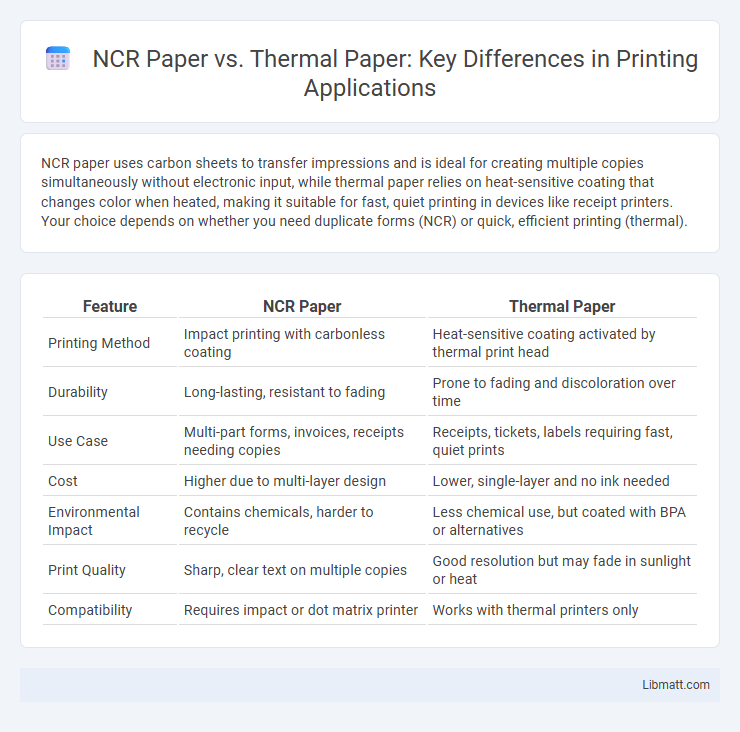NCR paper uses carbon sheets to transfer impressions and is ideal for creating multiple copies simultaneously without electronic input, while thermal paper relies on heat-sensitive coating that changes color when heated, making it suitable for fast, quiet printing in devices like receipt printers. Your choice depends on whether you need duplicate forms (NCR) or quick, efficient printing (thermal).
Table of Comparison
| Feature | NCR Paper | Thermal Paper |
|---|---|---|
| Printing Method | Impact printing with carbonless coating | Heat-sensitive coating activated by thermal print head |
| Durability | Long-lasting, resistant to fading | Prone to fading and discoloration over time |
| Use Case | Multi-part forms, invoices, receipts needing copies | Receipts, tickets, labels requiring fast, quiet prints |
| Cost | Higher due to multi-layer design | Lower, single-layer and no ink needed |
| Environmental Impact | Contains chemicals, harder to recycle | Less chemical use, but coated with BPA or alternatives |
| Print Quality | Sharp, clear text on multiple copies | Good resolution but may fade in sunlight or heat |
| Compatibility | Requires impact or dot matrix printer | Works with thermal printers only |
Introduction to NCR Paper and Thermal Paper
NCR paper, or No Carbon Required paper, is designed for creating instant copies without carbon sheets by using micro-encapsulated dye and reactive clay layers, making it ideal for multi-part forms like invoices and receipts. Thermal paper transforms when heat is applied to its special coating, enabling fast and efficient printing in devices such as receipt printers and calculators. Understanding the functional differences helps you select the right paper for your specific printing needs, balancing durability and cost-effectiveness.
What is NCR Paper?
NCR paper, also known as carbonless copy paper, is designed to transfer information written on the top sheet to multiple sheets beneath without the need for carbon paper. It contains micro-encapsulated dye or ink that reacts with a coated backing layer to create instant copies, ideal for multi-part forms, invoices, and receipts. Your choice of NCR paper ensures efficient record-keeping and reduces the mess and inconvenience associated with traditional carbon paper.
What is Thermal Paper?
Thermal paper is a specially coated paper designed to produce images or text when exposed to heat, eliminating the need for ink or ribbons. It is commonly used in point-of-sale receipts, labels, and tickets due to its fast printing capabilities and cost-effectiveness. Your choice of thermal paper ensures crisp, clear prints that are ideal for high-volume, quick printing environments.
Key Differences Between NCR and Thermal Paper
NCR paper uses a chemical coating to transfer impressions from one sheet to another, enabling multi-part forms without ink, while thermal paper relies on heat-sensitive coating to create images directly on the surface. Your choice depends on application needs: NCR is ideal for duplicate receipts or multi-copy forms, whereas thermal paper suits fast, single-copy printing like receipts or tickets. Thermal paper requires a thermal printer and is easier to handle, but NCR offers durability and clear copies without special devices.
Advantages of NCR Paper
NCR paper offers the distinct advantage of creating multiple copies simultaneously through its carbonless transfer technology, eliminating the need for messy carbon sheets. It ensures clean, clear, and durable reproductions ideal for invoices, receipts, and forms requiring legal or financial documentation. NCR paper's compatibility with standard ink printers and its resistance to smudging and fading enhance its reliability for long-term record keeping.
Advantages of Thermal Paper
Thermal paper offers significant advantages over NCR paper, including faster printing speeds and lower maintenance costs due to the absence of ink or ribbon replacement. It enables high-quality, smudge-resistant receipts that enhance durability and readability in retail and hospitality environments. This cost-effective solution reduces waste and improves efficiency, making it ideal for point-of-sale systems and receipt printers.
Common Uses of NCR Paper
NCR paper is commonly used in environments requiring multiple copies of the same document, such as invoices, purchase orders, and receipts. It enables instant duplication without the need for ink, making it ideal for businesses needing quick, carbonless copies for record-keeping or customer distribution. Your choice of NCR paper supports efficient documentation in retail, hospitality, and field service operations.
Common Uses of Thermal Paper
Thermal paper is commonly used in receipts, labels, and tickets due to its ability to produce images without ink, saving time and costs in high-volume printing environments. Unlike NCR paper, which is preferred for creating duplicates in forms and invoices, thermal paper is ideal for point-of-sale systems, medical devices, and logistics tracking where quick, clear printing is essential. Your choice depends on whether you need multi-part copies or fast, efficient printing for everyday transactions.
Environmental Impact: NCR vs Thermal Paper
NCR paper, often used for multi-part forms, typically contains chemical coatings that can complicate recycling processes and contribute to environmental waste. Thermal paper, common in receipts, frequently contains bisphenol A (BPA) or bisphenol S (BPS), which pose health and ecological risks when disposed of improperly. Choosing recycled or BPA-free thermal alternatives can reduce the environmental footprint compared to traditional NCR paper products.
Choosing the Right Paper for Your Business
Selecting the right paper for your business depends on the intended application and printing technology; NCR paper, also known as carbonless copy paper, is ideal for creating multi-part forms without messy carbon sheets, making it perfect for invoices, receipts, and order forms that require multiple copies. Thermal paper, coated with chemicals that change color when exposed to heat, is best suited for fast and efficient printing in point-of-sale systems, such as receipts and labels, providing crisp, smudge-free prints but lacking multi-copy functionality. Consider durability, print quality, and the need for duplicate records when deciding between NCR and thermal paper to enhance operational efficiency and customer experience.
NCR paper vs thermal paper Infographic

 libmatt.com
libmatt.com